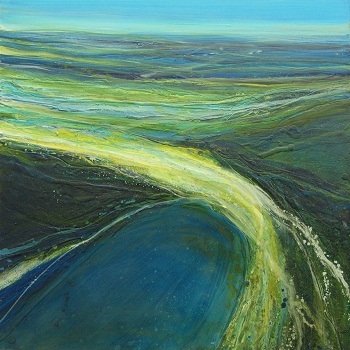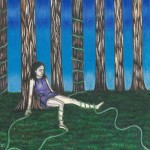A short story by Frank Rennie, inspired by Alison McGill’s painting ‘Coastal Aerial View’.
Support independent, non-corporate media.
Donate here!

I slumped back against the unyielding fabric of the seat with a crunch that hurt my shoulder. The thump winded me. I gave a grunt and glanced around the carriage in sudden self-awareness. No one paid any attention. My briefcase was on the table in front of me, and though I took out some papers and a pen, it was really just from force of habit. I didn’t feel like working. My eyes felt red, and I rubbed them without enthusiasm, overwork lying heavily upon me. Normally I would have spent the night in Glasgow, for – though I needed to be in Inverness the following morning – I could have worked in my hotel room, nipped out to visit a couple of the Partick bars on some flimsy business excuse, then caught an early train. Today, however, I was bitterly mindful of the Works Production Table. If I couldn’t secure these two new deals, stabilise the Section Trading Account, and come up with at least another Likely Prospect Account, I was certain that I would lose Production Points to Hamish Anderson. That would take me one step further down the Works Production Table and leave me second from the bottom, with only Eilidh MacKenzie between myself and being dropped off the Staff Team. I felt so tired.
My compartment on the Inverness train was almost half full. There was an old lady, a couple of other businessmen with their papers spread before them, and a few young, foreign- looking, passengers with bulging rucksacks and bulbous waist- bags. I stretched and tried to make myself comfortable as the engine picked up speed and headed north towards Stirling, Perth, and the Highlands. Not for the first time I wondered how I had ended up in this awful job. I doodled with my pen but leant back against the head-rest of the chair, trying to summon enough energy to finish drafting my preliminary report on the new merger. From where my head lay, I noticed a glimmer of daylight breaking through the shuttered window across the
central aisle. I sat up, intrigued, but I immediately lost sight of the bright spot. I lay back against the head-rest again, and, sure enough, the bright spot reappeared. Slowly, furtively, I glanced around the carriage. The other occupants were too engrossed in their reading materials to pay any attention to me. So without any fuss, I gathered my belongings and shifted to the seat across the passage. An old lady looked up at me but quickly resumed studying her magazine. I began doodling on my unlined notepad with earnest devotion.
After a few minutes, once I felt that the carriage had settled back into its comfortable somnolence, I casually investigated the window shuttering. At first sight the heavy plastic blinds, firmly secured all around the window, looked remarkable only for their complete lack of distinguishing features. Dull grey in colour, no graffiti, no patterns, it looked like any other shutter on the train, each firmly secured to prevent us “Standard Fare” passengers from being able to catch sight of the world beyond the train. Of course, if the carriage is needed for a higher grade service, the shutters could be unlocked and the price of each seat doubled (or trebled for First Class). On NewRail, seeing the view outside costs extra.
When I lay back in my seat I discovered that my eye was almost immediately opposite a sculpted hole in the edge of the blind, so carefully constructed that it disappeared when I sat up straight in my chair. I made a quick check to make sure that I was not being observed, then slid my eye closer to the hole. With a start I drew back! My heart began to thump! I could see right outside! Not since I had been a child, since before the days of the Monetarists market flotation of Scottish Rail, had I gazed out on the Highland landscape from a speeding train! I suppose I could have afforded to travel in a Viewing Compartment if I wanted to, but I never liked to do that when I was traveling on company time in case I got a reputation for being a spendthrift and a day- dreamer. (I knew better and less noticeable ways to day-dream!) Casually, I leaned towards the hole again.
We must be north of Perth by now, I thought, judging by the closeness of the hills and the profusion of birch trees close to the rail line. From time to time the panorama opened out, snatching a wider perspective through gaps in the trees, to reveal a real sense of spaciousness. The flashing patterns of the light, brilliant white, soft, diffuse, and dancing sunbeams, served to pick out the shaded areas more clearly. The brief images were powerful snapshots which blazoned themselves on my subconscious, registering every detail more clearly than if I had been given a longer time to study the scenes. Surreptitiously I kept an eye open for the ticket inspector on his rounds for I didn’t want the unpleasantness of being caught looking at the landscape without having paid for it! Yet it wasn’t an unpleasant feeling. It was as if I was snatching a goal against the opposition. I felt quite reckless with my new-found freedom.
For kilometer after kilometer I rode that train with my eye firmly fixed on the little hole in the shuttering, and through that hole I caught glimpses of the bright world of space outside. The artificial light inside the compartment became dull and dreary in comparison to the intensity of the countryside colours outside. Soon I began to notice the details of the flashing images. Birds, appeared on fence posts, cattle, sheep, and horses in the fields, occasional houses sped by, and grey ribbons of road, with multi- coloured cars trundling slowly in different directions. After a while I began to notice a consistency; horizontal rows of large, green-coloured pipes were running parallel to the railway track and would appear and disappear with the weaving of the landscape, only to reappear a few minutes later, still doggedly hugging my route north.
It took me a while to work out what these pipes might be, and then suddenly, turning a bend of the track, I was presented with a stupendous view of a highland loch. It wasn’t a large loch, but tree-ringed and so absolutely still that every image of the land and the sky was reflected in its surface. In that second I
realised the significance of the pipes – they must be a part of the water collection project which the company, Scottish Water Resources Unlimited, had initiated. I had read about the project in the Business News – the largest single water-collection system in Europe, collected from the landscape through a vein- like network of pipes over a huge area of countryside. I peered more closely, my curiosity aroused. The trees had closed in, hiding the view and darkening the immediate sky. It was at this point that I heard the wheels of the train slowing down, and on an impulse I bundled my papers into my briefcase, grabbed my overnight bag off the rack, and stepped out onto the short platform.
In less than the time taken to realise what station I was at (though I had heard it announced by the automatic speakers on the train) the compartment doors wheezed shut and the train slid away, leaving me completely alone with my luggage. I was a bit taken aback by my own behaviour, and to tell the truth, a bit at a loss for what to do next, but having come this far I decided that I might as well see something of the countryside. There were no luggage lockers, but my bags were not heavy, so I headed off through the terminal building towards the road outside. “Hey!” a voice shouted after me, and I had to have a furious wrangle with the station guard who wanted me to pay the Local Space Tax. I realised of course that personal space was taxable in crowded places such as public recreation areas, and airports, but I didn’t think that it also applied to Highland railway stations! When he started to list all the local services which I would be using by stepping out of that building – the pavement, the street lighting, even the local air ! – I knew that I was defeated and paid up with ill-grace so that I could hurry away from him.
A few hundred metres along the street, a small road turned off, and when I followed that, another appeared. Soon I found myself on a dry, dusty forestry road, with the sun broken by a mosaic of branches and the smell of pine needles in the air. I walked along for ages, until straining through the skeletal
trees, I caught sight of the rippling glimmer of sun reflected on water. I left the road and after a short scramble through the trees, during which I fell into almost every rabbit hole and scratched my face on the lowest branches, I reached the edge of a small loch. When I say the edge – it was technically the edge, because you could see where the bank of the loch normally would be, but there was only a small patch of water among several hectares of dried mud and boulders.
Setting my bags down on the bank, I picked my way carefully across the dried-up loch to the edge of the water. Really, it was a pitiful sight. For as far as the eye could discern between the trees, the bed of the loch was mostly dry, with a thin sliver of flat silver water at the base of the hollow. As I watched the pathetic wet patch, I noticed a vague movement of the dried leaves among the reflected light, a slow current, trailing debris across the surface. With my eye I followed the trail, walking around the watery edge, picking my way over recently drained gravel and wet stones. About four hundred metres on I discovered the cause of the current – a huge concrete-lined hole, which merged into a large, round, green pipe and disappeared off into the trees.
I stared in amazement. This loch was being literally drained into a pipeline! Looking up at the shoreline I saw now that almost all the trees fringing the loch were grey – dead, or dying, deprived of the water needed to keep them alive. There were no birds singing, or bathing in the hollows of muddy water. The landscape was being sucked dry. I staggered back to my bags and sat down upon my brief case, saddened by the implications of what I had just seen. I pictured hundreds, perhaps thousands, of similar lochs all over the Highlands, being drained to mud and boulders in order to sell the precious water to urban consumers in London, Paris and wherever else Scottish Water Resources Unlimited could sell the product. The thought was too depressing for words and I suddenly felt deflated.
For perhaps an hour or more I sat there, trying to piece together
the rationale of an economic system which claimed to be able to put a price on every single thing, living or non-living. To regard natural resources as ‘free’ products, to be drained to depletion simply because there is a market price that will be paid for them, was beyond my understanding. All my training as an economist yelled out that it was folly to eat into your capital assets and spend them as if they were water. Ha! I laughed out loud in spite of myself! In this case, spending water is exactly what we are doing! How ironic!
In the middle distance I heard a train rumbling past behind a screen of trees. It reminded me that I should be getting back to the station. I would be late in reaching Inverness even now, but if I missed another train I could kiss goodbye to getting any work done today. Slowly, with a heavier heart than on my outward journey, I scuffed my way back along the forest track towards the railway station. Then, just before the junction with the village road, I saw a large collection of pipes and valves and circular handles that I hadn’t noticed earlier. A sudden thought occurred to me, and with a quick check all around, though I hadn’t seen a single person since leaving the station, I slithered down the slope into the trees. I grasped the wheel of the largest valve on the pipework, and with another glance over my shoulder, began to turn the wheel. It was stiff with rust and paint, but after a few seconds straining it jerked into movement, and I spun it as fast as I could. For several silent seconds nothing seemed to happen. Then a sizzling jet of water burst forcefully from an opening valve. I continued to spin the wheel, and as the valve opened further, the thin spray became a torrent, then a jet, flying through the still air and splattering against the trees over thirty metres away.
I watched in awe, mesmerised by my own audacity, then as I saw the escaping water fill then burst beyond the confines of the nearest forestry ditch, I began to laugh to myself with sheer exhilaration. The water spilled into every runnel and hollow, scampering and bubbling further and further away from the confines of the pipeline. I saw the beginning of a small stream being formed and tumbling into the bed of the loch. Laughing, I kept spinning the wheel of the valve handle until it came off in my hands. With hardly a second thought, I threw the wheel as far into the forest as I could possibly manage, and picking up my bags again, I hurried back towards the station. Though I wanted to wait and see how far the unharnessed water would spread, I also wanted to be as far away from the scene as possible when the Water Police discovered the liberation from the pipeline.









